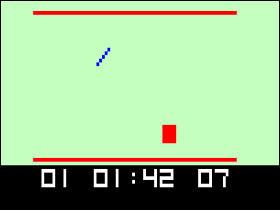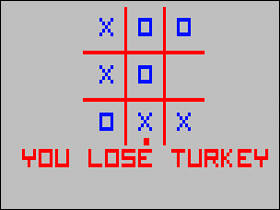 The Game: The first Channel F “Videocart” packs three games into one bright yellow package. Shooting Gallery is a straightforward target practice game in which players try to draw a bead on a moving target. Tic-Tac-Toe is the timeless game of strategy in small, enclosed spaces, and Quadradoodle is a simple paint program, long, long before its time. (Fairchild, 1976)
The Game: The first Channel F “Videocart” packs three games into one bright yellow package. Shooting Gallery is a straightforward target practice game in which players try to draw a bead on a moving target. Tic-Tac-Toe is the timeless game of strategy in small, enclosed spaces, and Quadradoodle is a simple paint program, long, long before its time. (Fairchild, 1976)
Memories: This is a game that changed everything. For the first time, owners of a home video game console could go into a store, buy something that was less pricey than the console itself, plug it into that console, and play new and different games. Rudimentary games by today’s standards, sure, but in every sense imaginable, Videocart #1 was a game changer.
 It’s also one of the first video games with attitude! Owing to the prevailing winds of the 1970s, your new Channel F would taunt you if you allowed it to beat you at Tic-Tac-Toe, with the bottom of the screen declaring “YOU LOSE TURKEY” in big red letters. Later generations of gaming hardware would make this trash talk more literal (the Odyssey2 voice synthesizer was known to call Smithereens! players turkeys in a cheerful, game-show-host-on-acid voice), but getting your ass handed to you by a computer – and then having the computer laugh at you for it (because, of course, it was programmed to) – started here.
It’s also one of the first video games with attitude! Owing to the prevailing winds of the 1970s, your new Channel F would taunt you if you allowed it to beat you at Tic-Tac-Toe, with the bottom of the screen declaring “YOU LOSE TURKEY” in big red letters. Later generations of gaming hardware would make this trash talk more literal (the Odyssey2 voice synthesizer was known to call Smithereens! players turkeys in a cheerful, game-show-host-on-acid voice), but getting your ass handed to you by a computer – and then having the computer laugh at you for it (because, of course, it was programmed to) – started here.
Tic-Tac-Toe even got a national TV product placement of sorts, appearing in an early episode of the Saturday morning kids’ sci-fi show Space Academy – clearly the Channel F was the future.
Quadradoodle, the oft-overlooked third selection on Videocart #1’s menu, should also be given its due: long before MacPaint or anything with the word “Adobe” before it, this was among the very first consumer-level applications that would let its users directly control a picture on their TV screens (beyond the relatively recent luxury of TV remote controls). The Channel F’s unusual color  palette – predominantly red, green, and a faded “institutional” green-blue – didn’t lend itself to great works of art, but the kaleidoscopic “mirror” options were amusing enough. It was something that, before Channel F came along, one couldn’t do on an average TV screen. Not a bad trio of games for the first video game cartridge.
palette – predominantly red, green, and a faded “institutional” green-blue – didn’t lend itself to great works of art, but the kaleidoscopic “mirror” options were amusing enough. It was something that, before Channel F came along, one couldn’t do on an average TV screen. Not a bad trio of games for the first video game cartridge.